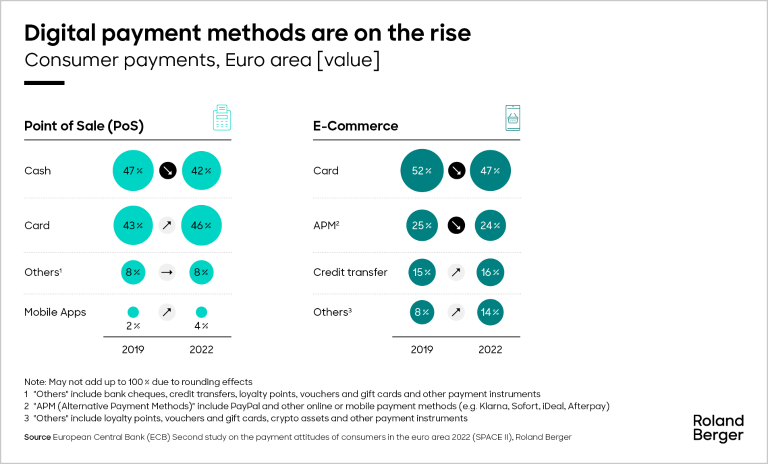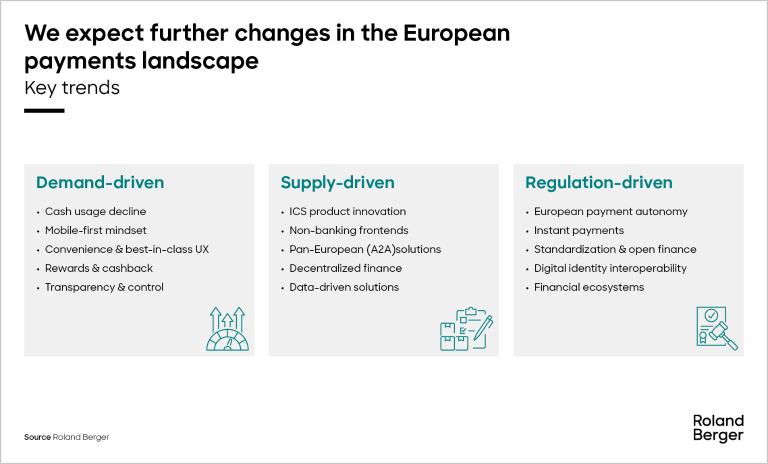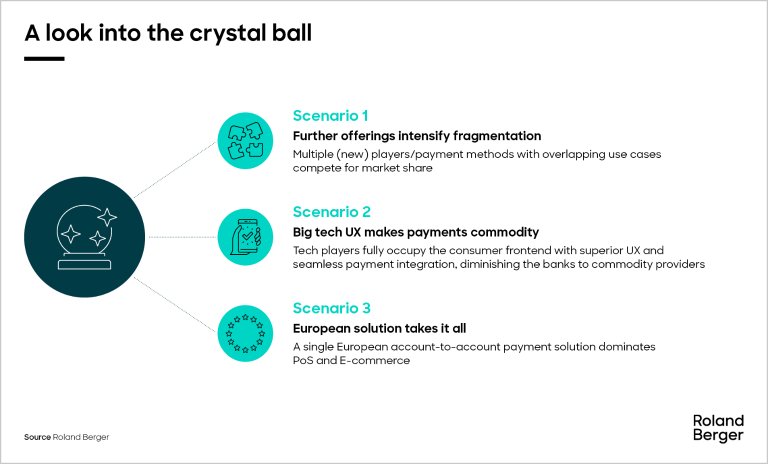New Roland Berger and Solaris report on how to drive revenue growth.


Trends to watch: The future of European retail payments
A fragmented payments market races to meet evolving consumer demand
The European payments landscape is undergoing a shift, driven by digitalization and changing consumer preferences. Multiple trends and initiatives are challenging the status quo and having a substantial impact on the future payments mix. Roland Berger envisions potential scenarios and outlines immediate measures for action.

"Europe faces the challenge of balancing payment innovation from established providers with the need for a unified, pan-European strategy. The success of initiatives such as EPI or the Digital Euro could play a crucial role in shaping the continent's financial future."
The decline of cash and rise of digital
At the point of sale, cash usage has seen a marked decline, dropping from 47% in 2019 to 42% in 2022. This shift has been accompanied by a rise in card payments, which increased from 43% to 46% over the same period.
Mobile app payments have doubled their market share, rising from 2% to 4%, indicating a growing demand for convenient, contactless payment solutions.
The E-commerce sector tells a different story. While cards remain dominant, their share has decreased from 52% in 2019 to 47% in 2022. This decline comes as consumers increasingly embrace alternative payment methods (APMs) such as digital wallets, buy-now-pay-later (BNPL) services, and account-to-account (A2A) payments.
As these digital trends continue to reshape the payments landscape, they also bring renewed attention to a persistent challenge in the European market: fragmentation.
"We're seeing a fundamental shift in how Europeans interact with money. Companies that offer seamless experiences across banking, e-commerce, and daily finances will lead the market."
A fragmented market seeking unity
Despite the push towards digital solutions, the European payment market remains highly fragmented. Domestic solutions in countries such as Germany, France and Italy continue to hold strong positions in their respective markets. However, their limited functionality in terms of jurisdictions and use cases has left the door open for international players like Visa and Mastercard to dominate pan-European transactions.
Efforts to create a unified European solution are underway, aiming to address this fragmentation. The European Payments Initiative (EPI), currently operational in selected EU countries, aims to offer a pan-European A2A system. This initiative seeks to reduce dependence on non-European providers and address the longstanding issue of market fragmentation.
Europe faces the challenge of balancing payment innovation from established providers with the need for a unified, pan-European strategy. The success of initiatives such as EPI or the Digital Euro could play a crucial role in shaping the continent's financial future.
This push for unity is occurring against a backdrop of rapid change, driven by several key trends.
Key trends shaping the future
The European payments landscape is being reshaped by three main forces: consumer demand, provider innovation, and regulatory initiatives. These trends are not only redefining how payments are made today but are also influencing the future strategies of payment providers and financial institutions.
Demand-driven trends: The consumer perspective
From the consumer side, several key trends are emerging:
- Cash Usage Decline: There's a clear shift away from cash, with digital payment methods becoming an essential part of everyday life.
- Mobile-First Mindset: Consumers are increasingly adopting a mobile-first approach, using smartphones and apps as their primary tools for managing and making payments.
- Convenience & Best-In-Class UX: The growing demand for convenient solutions is driving the popularity of innovations like contactless payments and seamless checkout processes. Tech Players exemplify this trend, offering secure, fast, and integrated payment experiences across various devices.
- Rewards and Loyalty: Consumers are increasingly drawn to payment options that offer rewards and cashback. Loyalty programs are providing added value for each transaction, influencing consumer payment choices.
- Transparency & Control: There's a growing demand for greater transparency and control over personal finances. Multi-banking apps like Finanzguru, which aggregate multiple accounts, and services that offer real-time transaction tracking and spending analytics, are helping consumers manage their money more effectively.
Supply-driven trends: The provider perspective
On the provider side, several innovations are shaping the market:
- Product Innovation by Traditional Players: International card schemes like Visa and Mastercard are responding to market shifts with new products. They're introducing new solutions like A2A or click-to-pay. Further, they are actively driving deeper market penetration.
- Non-Banking Frontends: Solutions from tech companies like Apple Pay and Google Pay are enabling users to store multiple cards digitally and make contactless payments with just a smartphone tap. These platforms integrate various financial services and apps, providing a single interface for payments, loyalty cards, and even transit passes.
- Account-to-Account (A2A) Payments: A2A solutions are gaining momentum, particularly in E-commerce and P2P transactions. Successful examples like Blik (Poland), Swish (Sweden), and Payconiq (Belgium) offer faster, more direct payment processes that bypass traditional card networks. The European Payments Initiative (EPI) represents a push towards creating a pan-European A2A solution.
- Decentralized Finance (DeFi): Blockchain-based platforms like Uniswap and Compound are opening new avenues for P2P transactions and smart contracts, potentially reducing costs and increasing transaction speed by removing traditional financial intermediaries.
- Data-Driven Solutions: Companies like Square and Klarna are leveraging big data and AI to offer personalized and secure payment experiences. This includes AI-driven fraud detection systems and tailored financing options at the point of sale.
Regulation-driven trends: The supervisory perspective
Regulatory initiatives are playing an increasingly important role in shaping the future of European payments:
- European Payment Autonomy: There's a push to enhance European payment sovereignty by reducing reliance on global card schemes. Projects like the Digital Euro aim to foster autonomy within the European payment market.
- Instant Payments: The drive for faster transactions is accelerating, with initiatives like SEPA Instant Credit Transfer being promoted as the new standard, enabling real-time transfers 24/7.
- Standardization & Open Finance: Building on the foundation laid by PSD2, the upcoming PSD3 is expected to address implementation inconsistencies and expand the scope of open finance beyond banking to include insurance, pensions, and investments.
- Digital Identity Integration: The EU Digital Identity Wallet initiative aims to create a standardized digital identity solution across the EU, streamlining identity verification processes.
- Financial Data Access: The Financial Data Access (FIDA) framework is set to revolutionize how financial data is accessed and shared across services, potentially driving innovation and fostering competition in the financial sector.
These trends are setting the stage for significant changes in the European payments landscape, influencing everything from consumer behavior to business strategies and regulatory frameworks. As these forces continue to shape the market, they are also creating potential future scenarios that could significantly transform the payments ecosystem.
Potential future: Three scenarios for European payments
As the European payments landscape continues to evolve, three potential scenarios have been identified that could heavily shape the future of the market:
- Further offerings intensify fragmentation: In this scenario, the rush to innovate leads to an acceleration of market fragmentation. Both existing players and new entrants introduce a wide array of payment solutions, creating a patchwork system where no single provider dominates. Despite regulatory efforts to unify the market, the sheer diversity of competing solutions maintains a fragmented landscape.
- Big tech UX makes payments commodity: This scenario sees tech giants taking a leading role in consumer-facing payment solutions. Leveraging their vast resources, broad user bases, and expertise in user-centric design, these companies create intuitive digital interfaces that simplify and enhance the payment process. By integrating payments into broader ecosystems of shopping, transportation, and entertainment, they provide consumers with a seamless experience that could reshape the competitive landscape.
- European Solution takes it all: The third scenario envisions the realization of European payment autonomy. Driven by regulatory initiatives like the Digital Euro or private sector efforts such as the European Payments Initiative (EPI), this future sees the convergence of diverse payment methods into a single, dominant system. While this could strengthen European sovereignty and economic integration, it may also present challenges for smaller players and potentially impact innovation in the sector.
The path Europe ultimately takes will depend on how effectively it balances innovation, regulation, and market forces. Each scenario presents unique opportunities and challenges for both established players and new entrants in the payments space.
As these potential futures loom on the horizon, market players must take decisive action to position themselves for success, regardless of which scenario unfolds.
Charting the course: Immediate actions for market players
To remain competitive in this evolving landscape, market players should consider six key steps to stay ahead of the game:
- Define Strategic Positioning: Market players must clarify their role in the payments ecosystem, aligning with initiatives like the Digital Euro or EPI to guide resource allocation and growth priorities.
- Enhance Customer Touchpoints: Creating unique customer experiences is crucial. Investing e.g., in AI and machine learning can help market players anticipate customer needs and build stronger relationships through personalized, omnichannel interactions.
- Engage in Regulatory Discussions: Active participation in shaping European initiatives allows market players to potentially influence policies and better prepare for new rules and standards.
- Leverage Strategic Partnerships: Collaborations with fintechs, banks, or tech firms can help businesses enhance offerings, share innovation costs, and scale faster in a fragmented market.
- Modernize IT Infrastructure: Upgrading IT infrastructure is crucial for supporting emerging payment technologies and ensuring scalability, with cloud-based systems, enhanced cybersecurity, and AI-driven insights enabling businesses to remain flexible, secure, and deliver faster product deployment.
- Boost Cost Efficiency: As investments in technology and innovation are expected to increase, streamlining operations and optimizing processes through automation will be key to maintaining profitability.
The payments industry is witnessing a fundamental shift in how Europeans interact with money. Companies that offer seamless experiences across banking , E-commerce, and daily finances are likely to lead the market in the coming years.
"Thriving in the European payments market means driving innovation, enhancing security, staying ahead of regulatory changes, and delivering a seamless digital payments experience – all powered by cutting-edge technology."
The road ahead
The future of European payments is being shaped by a complex interplay of technological advancements, evolving consumer expectations, and regulatory shifts. As we've seen, the market could evolve in several directions, from increased fragmentation to big tech dominance or a unified European solution. Each of these potential futures will require different strategies from market players.
One thing is clear: success in this new era of digital payments will belong to those who can adapt quickly and strategically. By focusing on customer engagement, staying ahead of regulations, building smart partnerships, and optimizing operations, businesses can position themselves to thrive regardless of which scenario unfolds.
As Europe stands at this financial crossroads, the actions taken today by market players, regulators, and innovators will determine the shape of payments for generations to come. The race is on to create a payment landscape that is not only more efficient and secure but also uniquely European in its approach and values.
The coming years promise to be a period of unprecedented change and opportunity in the European payments sector. Those who can navigate this complex landscape with agility and foresight will be well-positioned to lead in the digital economy of tomorrow.












